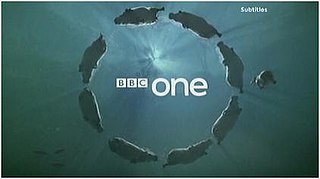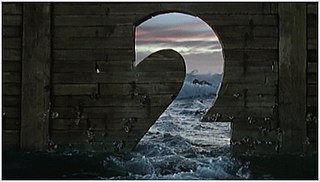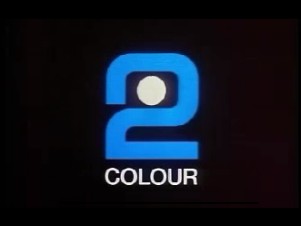
The BBC Two 'Two' ident was the station identification used on BBC2 between 30 March 1986 and 16 February 1991. [1] It was the last non-corporate look for the channel, and the only look until 2018 that did not feature a numeral '2' in the design.

The BBC Two 'Two' ident was the station identification used on BBC2 between 30 March 1986 and 16 February 1991. [1] It was the last non-corporate look for the channel, and the only look until 2018 that did not feature a numeral '2' in the design.
Following their previous and groundbreaking striped 2 look, BBC Two wanted to go in a different programming direction. The ident they had commissioned had been around since 1979 and after seven years' service, it was time for a replacement. The channel wanted to aim programming that was more high brow and sophisticated. [2] As a result, they wanted the new logo to reflect this. The BBC commissioned Alan Jeapes, [1] [2] [3] who was responsible for the title sequence for BBC1's hit soap EastEnders the year before, to create the new look.
The ident for the look featured a white background with embossed, 3D lettering spelling out 'TWO' in a stencil style font. [1] [2] [4] The 'TWO' are coloured red, green and blue to represent the phosphors of television, and was a device the channel had used before (they also represented the national colours of Wales, Northern Ireland and Scotland respectively). The upright part of the 'T' was coloured red, the left hand diagonal of the 'W' green and the middle diagonal blue. The 'O' remained white, as did the remainder of the lettering. Similar to the last look, the lettering would either fade in from the background, fade out into the background, or remain on screen the whole time. [1] [2] [3] There were no particular rules for which ident should be shown when, but the fade in and fade out versions were often used for the start and end of day respectively. [3] For Subtitled programming, a small grey hard of hearing logo was located between the 'T' and 'W' of the 'TWO', with the caption '888' situated below the logo. [1] [2] [4]
A clock accompanied the look, as was common for the channel in these days. The clock had a white background, with embossed dashes at each position round the clock face. The 'TWO' logo was placed below the clock, with the clock hands different colours: a red second hand, a green minute hand and a blue hour hand. The clock was electronically generated using the previous clock generator system and was often used before some news bulletins and before closedown. On this occasion, the clock would always fade to white, before fading to black. [1] [2] [4]
The promotional style used with the look varied throughout the time. Promotions themselves featured no unifying look and changed with seasons. [5] [6] The only key factor was that the 'TWO' logo would appear in some form at the end, but this was not always guaranteed. At this time, programme slides were still being used frequently in continuity on both channels. At the beginning of this period, the technology was not yet in place for electronic captions, meaning that the original caption design needed to work on optical slides: it therefore needed to be a simple design. The original design involved a black strip across the bottom of the screen which included the 'TWO' on the left and the programme title on the right. [4] [5] Following the acquisition of Quantel Paintbox however, the slides were now electronically generated allowing the 'TWO' to appear not only 3D but on a white background. The new design featured the bottom half of the screen in white with 3D logo and name, with the white background fading upwards into the picture, in a similar design to the previous version. [7] This was later modified to a single white gradiented strip, the width of the 'TWO' logo on the left hand side with the programme name overlaid the picture, which now occupies the whole of the screen. [4] [5] For cross promotional captions, BBC1 used a white caption, with the picture inside a box in the centre of the caption, with 'TWO' logo and name located above the box. [5] This style was not used on the main channel. This was created using old CG. But in 2010, The ident was recreated using 3D software.
This look also marked the first time that the regions could opt out of the main BBC2 schedule, following the move of some programming to the channel from BBC1. To differentiate, regional versions of the 'TWO' ident were made, with the region name in grey over a static caption of the TWO logo. [4] [8]
In 1990, the newly recruited BBC2 controller, Alan Yentob, noticed that the logo for the channel, the 'TWO', was affecting the reputation of BBC2. Surveys commissioned realised that most viewers thought the new look "dull" and "worthy". [9] He then decided to commission a worthy successor capable of displaying the personality of the channel, revealing his thoughts in the How Do They Do That? episode - about the idents. [9] The successors were introduced on 16 February 1991. However, in 2010, for the 80's season. the 'TWO' logo made an appearance. And on 7 October 2013, this, along with others was brought back for BBC Two's "Afternoon Classics" block.
BBC2 used a number of special idents through its years, mainly for use at Christmas. Special idents were commissioned for this.
A few other special idents were made:

The BBC One Balloon idents were a series of idents used on the British TV channel BBC One from 4 October 1997 to 28 March 2002. The balloon theme replaced the computer-generated spinning globe that had been used as the main ident on the channel since 1991. It launched on the same day as a BBC-wide rebrand, and thus the new idents also carried the new BBC logo. The channel's name also changed from BBC1 to BBC One. This was the last ident set used by the channel when it fully closed down; the last proper closedown took place in the early hours of 9 November 1997. Starting the following day, BBC News 24 would broadcast on BBC One during closedown, which continues today.

The BBC One 'Rhythm & Movement' idents were a set of on-screen channel identities designed by Lambie-Nairn and used on BBC One from 29 March 2002 to 7 October 2006. They replaced the balloon idents, and spelled the end of the much recognised globe identity by the BBC, which had been used in various ways since 1963.

Noddy was a camera system used for generating idents for the BBC One and BBC Two television channels from late 1963 to February 1985.
The history of BBC television idents begins in the early 1950s, when the BBC first displayed a logo between programmes to identify its service. As new technology has become available, these devices have evolved from simple still black and white images to the sophisticated full colour short films seen today. With the arrival of digital services in the United Kingdom, and with them many more new channels, branding is perceived by broadcasters to be much more important, meaning that idents need to stand out from the competition.

The Computer Originated World (COW) was the method of creating the BBC1 symbol that was used between 18 February 1985 and 16 February 1991. It was later used by the international, commercial television service BBC World Service Television from its launch until 26 January 1995.

The BBC One 'Circle' idents were a set of on-screen channel identities used on BBC One from 7 October 2006 to 4 December 2016. They also featured on the BBC Studios channel, BBC America. The idents contained images of circles being formed by nature, or people and their actions. This was the longest set of idents that was used by BBC One, as they lasted for 10 years.

The BBC Two '1991–2001' idents were broadcast from 16 February 1991 until 19 November 2001, and again from 9 July 2014 until 26 September 2018, on BBC Two in the United Kingdom. The idents, which consisted of a sans-serif '2' in Gill Sans, accompanied by the colour viridian, were created by branding agency Lambie-Nairn, who also created the Channel 4 logo.

The "Virtual Globe" was the method of creating the BBC1 symbol that was used between 16 February 1991 and 4 October 1997.

BBC Select was an overnight television service run by the BBC during the hours when BBC1 or BBC2 had closed down, usually between 2am and 6am. The channel showed programming intended for specialist audiences, such as businessmen, lawyers, nurses and teachers, and was designed to be viewed after broadcast via a video recording. It was funded by a subscription, and most programming was scrambled.
The logo of the BBC has been a brand identity for the corporation and its work since the 1950s in a variety of designs. Until the introduction of a logo in 1958, the corporation had relied on its coat of arms for official documentation and correspondence, although this crest rarely appeared onscreen. With the increased role of television for the BBC in the 1960s, particularly after the foundation of ITV, the corporation used its logo to increase viewer familiarity and to standardise its image and content. The logo has since been redesigned a number of times, most recently in 2021 with the BBC blocks, a logo designed to work across media. From 1958, for this television network, there have been six different logos. The first logo of the network was used from 1958 to 1963, the second from 1963 to 1971, the third from 1971 to 1992, the fourth from 1988 to 1997, the fifth from 1997 to 2021, while the sixth and current logo was adopted in October 2021.

The BBC TwoPersonality idents were a set of idents used on BBC Two from 19 November 2001 until 18 February 2007. The idents were produced by the Lambie-Nairn branding agency, who had created the previous look. The idents feature an ivory sans serif white '2' in a yellow environment and performing a variety of tasks, and a purple boxed BBC Two logo.
BBC Schools, also known as BBC for Schools and Colleges, is the educational programming strand set up by the BBC in 1957, broadcasting a range of educational programmes for children aged 5–16. From launch until June 1983, programming was based on BBC1 during the daytime, apart from coverage of major news events which saw the programmes shifted to BBC2. In September 1983 programming was transferred permanently to BBC2 freeing BBC1 to develop its own daytime schedule. The strand, named Daytime on Two, remained on BBC Two until March 2010, later supplemented by the 'Class TV' strand on the CBBC Channel.
BBC One used a number of different idents from the time of the station launch on 2 November 1936 until the station took on the Mirror Globe Idents on 15 November 1969.

The Window on the World idents were a set of idents used by BBC Two from 18 February 2007 until late 2014. They were created by Abbott Mead Vickers BBDO and produced by Red Bee Media. The idents featured a number 2 cut out of, or made out of parts of the everyday environment.

The Computer Generated 2 was an ident used by BBC Two between June 1979 and 30 March 1986. It was the first computer generated television station identification in the world.
The Striped 2 was an ident used by BBC2 between 28 December 1974 and June 1979. The ident featured a numeral 2 made out of horizontal lines.

The Cube 2 was an ident used by BBC Two between 2 December 1967 and 28 December 1974. It featured a stylised '2' that rotated on screen.

The Launch ident was a television station identification used by BBC Two between their launch night in 1964 and the introduction of colour in 1967.
Throughout the years, Children's BBC, and later CBBC and CBeebies, have used a number of different identities. The branding of the stranded service is distinctive both in the past and at present.
The presentation and the identities of the BBC News Channel, the international counterpart BBC World News and the BBC Parliament coverage channel use specific identities that demonstrate their remit and purpose.